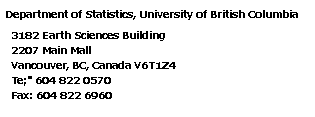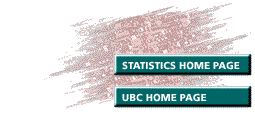 |
||
|
|
||
|
[ N.E. Heckman's Home ]
|
|
N. E. Heckman
I am interested in non-parametric, or smoothing, regression. In the general regression problem, each Y observation is assumed to depend upon an observed variable, x. In classical (parametric) regression, the form of this dependence is quite specific. For instance,
one might assume that Y is linear in x, with random error. The least squares regression estimate of the linear relationship is easy to find, often without a calculator. And a linear dependency of Y upon x is certainly easy to picture.
The widespread use of computers has reduced the need for easily calculated estimates of the relationship between variables. And the development of computer graphics allows the statistician to literally look at forms of dependencies which are far more complex than the
classically assumed linear relationships. Instead of determining the "best-fitting" line, one can calculate and graph a "best-fitting smooth curve", through such computer-intensive techniques as spline and kernel smoothing.
My research interests in non-parametric regression have focused in several areas: semi-parametric models, regression function shape, non-normal likelihoods, and model-based penalties.
In the semi-parametric model, one assumes that the expected value of Y is a's + g(t), where a is an unknown parameter vector, g is an unknown but smooth function and s and t are known covariates. This compromise between parametric and smoothing regression allows one to estimate a as accurately as one could if one knew the exact form of g.
Smoothing methods are often used to help a researcher study the shape of a regression function, or to determine if the regression function shows certain features, such as a bump. Often the determination of such shape characteristics are of greater interest than the
actual estimation of the regression function. I have studied the problem of "bump-hunting" and of examining the convexity of a regression function.
Many standard smoothing methods have been developed to handle the case of normally distributed responses. I am interested in extending these methods to other models, including generalized linear models (e.g., Poisson data) and backcalculation models, which arise in the estimation of the rate of HIV infection in the population.
Although smoothing methods are seemingly non-model dependent, they do implicitly use a model. One can make use of model information to more accurately estimate a regression function. This is easily done via penalized likelihood.
If you want to learn more about smoothing methods, see the
web site for my course notes.
If you want to download smoothing software see
my
list of sites.
|
|
[ Return to N.E. Heckman's Home Page ] |
||
 |
 |
